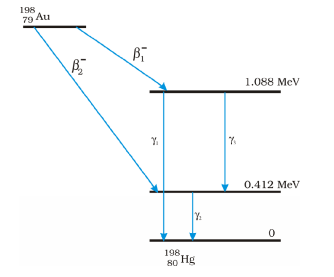EXERCISE from PSEB Chapter 11 NUCLEI for Class 12
| Class 12 | PHYSICS |
| Chapter | NUCLEI |
| PSEB | EXERCISE |
| Medium | English |
| Academic Year | 2023-2024 |
Question 16
The normal activity of living carbon-containing matter is found to be about 15 decays per minute for every gram of carbon. This activity arises from the small proportion of radioactive 146C present with the stable carbon isotope 126C . When the organism is dead, its interaction with the atmosphere (which maintains the above equilibrium activity) ceases and its activity begins to drop. From the known half-life (5730 years) of 146C , and the measured activity, the age of the specimen can be approximately estimated. This is the principle of 146Cdating used in archaeology. Suppose a specimen from Mohenjodaro gives an activity of 9 decays per minute per gram of carbon. Estimate the approximate age of the Indus-Valley civilisation.View SolutionQuestion 22
The radionuclide 11C decays according to 116C → 115B + e+ + v : T12 = 20.3 min .The maximum energy of the emitted positron is 0.960 MeV. Given the mass values: m (116C) = 11.011434 u and m ( 116B) = 11.009305 u, calculate Q and compare it with the maximum energy of the positron emitted.View SolutionQuestion 24
The Q value of a nuclear reaction A+b→C+d is defined by Q=[mA+mb−mC−md]c2where the masses refer to the respective nuclei. Determine from the given data the Q-value of the following reaction and state whether the reaction is exothermic or endothermic. 11H+31H→21H+21H Atomic masses are given to be m (21H) = 2.014102 u m (31H) = 3.016049 uView SolutionQuestion 25
The Q value of a nuclear reaction A+b→C+d is defined by Q=[mA+mb−mC−md]c2where the masses refer to the respective nuclei. Determine from the given data the Q-value of the following reaction and state whether the reaction is exothermic or endothermic. 126C+ 126C→2010Ne + 42He Atomic masses are given to be m(126C ) = 12.000000 u m(2010Ne ) = 19.992439 u View SolutionQuestion 28
A 1000 MW fission reactor consumes half of its fuel in 5.00 y. Howmuch 23592Udid it contain initially? Assume that the reactor operates80% of the time, that all the energy generated arises from the fission of 23592 U and that this nuclide is consumed only by the fission process.View SolutionQuestion 30
Calculate the height of the potential barrier for a head on collision of two deuterons. (Hint: The height of the potential barrier is given by the Coulomb repulsion between the two deuterons when they just touch each other. Assume that they can be taken as hard spheres of radius 2.0 fm.)View SolutionQuestion 32
For the β+ (positron) emission from a nucleus, there is another competing process known as electron capture (electron from an inner orbit, say, the K emitted). e+ + AZX → AZ−1Y + v . Show that if β+ emission is energetically allowed, electron capture is necessarily allowed but not vice-versaView SolutionQuestion 33
In a periodic table the average atomic mass of magnesium is given as 24.312 u. The average value is based on their relative natural abundance on earth. The three isotopes and their masses are 2412Mg (23.98504u), 2512Mg (24.98584u) and 2612Mg (25.98259u). The natural abundance of 2412Mg is 78.99% by mass. Calculate the abundances of other two isotopes.View SolutionQuestion 34
The neutron separation energy is defined as the energy required to remove a neutron from the nucleus. Obtain the neutron separation energies of the nuclei 4120Ca and 2713Al from the following data: m(4020Ca) = 39.962591 u m(4120Ca)= 40.962278 u m(2613Al) = 25.986895 u m(2713Al ) = 26.981541 uView SolutionQuestion 36
Under certain circumstances, a nucleus can decay by emitting a particle more massive than an α-particle. Consider the following decay processes: 22388Ra → 20982Pb + 146C , 22388Ra → 21986Rn+ 42He .Calculate the Q-values for these decays and determine that both are energetically allowed.View SolutionQuestion 37
Consider the fission of 23892U by fast neutrons. In one fission event, no neutrons are emitted and the final end products, after the beta decay of the primary fragments, are 14058Ce and 9944Ru . Calculate Q for this fission process. The relevant atomic and particle masses are m( 23892U) =238.05079 u m(14058Ce ) =139.90543 u m( 9944Ru) = 98.90594 uView SolutionQuestion 43
Suppose India had a target of producing by 2020 AD, 200,000 MW of electric power, ten percent of which was to be obtained from nuclear power plants. Suppose we are given that, on an average, the efficiency of utilization (i.e. conversion to electric energy) of thermal energy produced in a reactor was 25%. How much amount of fissionable uranium would our country need per year by 2020? Take the heat energy per fission of 235U to be about 200MeV.View Solution

